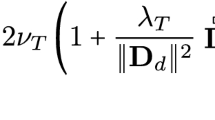Abstract
The realizability of Reynolds stress models in homogeneous turbulence is critically assessed from a theoretical standpoint. It is proven that a well known second-order closure model formulated using the strong realizability constraints of Schumann (1977) and Lumley (1978) is, in fact, not a realizable model. The problem arises from the failure to properly satisfy the necessary positive second time derivative constraint when a principal Reynolds stress vanishes-a flaw that becomes apparent when the nonanalytic terms in the model are made single-valued as required on physical grounds. More importantly, arguments are advanced which suggest that it is impossible to identically satisfy the strong from of realizability in any version of the present generation of second-order closures. On the other hand, models properly formulated to satisfy the weak form of realizability—wherein states of one or two component turbulence are made inaccessible in finite time via the imposition of a positive first derivative condition—are found to be realizable. However, unlike the simpler and more commonly used second-order closures, these models can be ill-behaved near the extreme limits of realizable turbulence due to the way that higher-degree nonlinearities are often unnecessarily introduced to satisfy realizability. Illustrative computations of homogeneous shear flow are presented to demonstrate these points which can have important implications for turbulence modeling.
Similar content being viewed by others
References
Abid, R. and Speziale, C. G. (1993). Predicting equilibrium states with Reynolds stress closures in channel flow and homogeneous shear flow,Phys. Fluids A 5, 1776–1782.
Deardorff, J. W. (1973). The use of subgrid transport equations in a three-dimensional model of atmospheric turbulence,ASME J. Fluids Eng. 95, 429–438.
Durbin, P. A. and Speziale, C. G. (1994). Realizability of second moment closure via stochastic analysis,J. Fluid Mech. 280, 395–407.
Fu, S., Launder, B. E., and Tselepidakis, D. P. (1987). Accommodating the effects of high strain rates in modeling the pressure-strain correlation, UMIST Technical Report TFD/87/5.
Gibson, M. M. and Launder, B. E. (1978). Ground effects on pressure fluctuations in the atmospheric boundary layer,J. Fluid Mech. 86, 491–511.
Goldstein, H. (1980).Classical Mechanics, 2nd ed., Addison-Wesley.
Haworth, D. C. and Pope, S. B. (1986). A generalized Langevin model for turbulent flows,Phys. Fluids 29, 387–405.
Hinze, J. O. (1975).Turbulence, 2nd ed., McGraw-Hill.
Kraichnan, R. H. (1961). Dynamics of nonlinear stochastic systems,J. Math. Phys. 2, 124–130.
Launder, B. E., Reece, G. J., and Rodi, W. (1975). Progress on the development of a Reynolds stress turbulence closure,J. Fluid Mech. 68, 537–566.
Lee, M. J., Kim, J., and Moin, P. (1990). Structure of turbulence at high shear rate,J. Fluid Mech. 216, 561–583.
Lumley, J. L. (1978). Computational modeling of turbulent flows,Adv. Appl. Mech. 18, 123–176.
Lumley, J. L. (1983). Turbulence modeling,ASME J. Appl. Mech. 50, 1097–1103.
Mellor, G. L. and Herring, H. J. (1973). A survey of mean turbulent field closure models,AIAA J. 11, 590–599.
Orszag, S. A. (1977). Statistical theories of turbulence, inFluid Dynamics, Les Houches, Gordon and Breach.
Pope, S. B. (1985). Pdf methods for turbulent reactive flows,Prog. Energy Combust. Sci. 11, 119–192.
Pope, S. B. (1994). On the relationship between stochastic Lagrangian models of turbulence and second-moment closures,Phys. Fluids 6, 973–985.
Reynolds, W. C. (1987). Fundamentals of turbulence for turbulence modeling and simulation, inLecture Notes for Von Karman Institute, AGARD Lect. Ser. No. 86, pp. 1–66, NATO.
Rogers, M. M., Moin, P., and Reynolds, W. C. (1986). The structure and modeling of the hydrodynamic and passive scalar fields in homogeneous turbulent shear flow, Stanford University Technical Report TF-25.
Sarkar, S. and Speziale, C. G. (1990). A simple nonlinear model for the return to isotropy in turbulence,Phys. Fluids A 2, 84–93.
Schumann, U. (1977). Realizability of Reynolds stress turbulence models,Phys. Fluids 20, 721–725.
Shih, T. H. and Lumley, J. L. (1985). Modeling of pressure correlation terms in Reynolds stress and scalar flux equations, Cornell University Technical Report FDA-85-3.
Shih, T. H., Chen, J. Y., and Lumley, J. L. (1992). Second-order modeling of boundary free turbulent shear flows,AIAA J. 30, 1553–1560.
Shih, T. H. and Lumley, J. L. (1993). Critical comparison of second-order closures with direct numerical simulations of homogeneous turbulence,AIAA J. 31, 663–670.
Speziale, C. G. (1990). Discussion of turbulence modeling: present and future, inLecture Notes in Physics, J. L. Lumley (ed), Springer-Verlag, pp. 490–512.
Speziale, C. G. (1991). Analytical methods for the development of Reynolds stress closures in turbulence,Ann. Rev. Fluid Mech. 23, 107–157.
Speziale, C. G., Gatski, T. B., and Mac Giolla Mhuiris, N. (1990). A critical comparison of turbulence models for homogeneous shear flows in a rotating frame,Phys. Fluids A 2, 1678–1684.
Speziale, C. G., Gatski, T. B., and Sarkar, S. (1992). On testing models for the pressure-strain correlation of turbulence using direct simulations,Phys. Fluids A 4, 2887–2899.
Tavoularis, S. and Corrsin, S. (1981). Experiments in nearly homogeneous turbulent shear flow with a uniform mean temperature gradient. Part I,J. Fluid Mech. 104, 311–347.
Tavoularis, S. and Karnik, U. (1989). Further experiments on the evolution of turbulent stresses and scales in uniformly sheared turbulence,J. Fluid Mech. 204, 457–478.
Zeman, O. and Lumley, J. L. (1976). Modeling buoyancy-driven mixed layers,J. Atmos. Sci. 33, 1974–1988.
Author information
Authors and Affiliations
Rights and permissions
About this article
Cite this article
Speziale, C.G., Abid, R. & Durbin, P.A. On the realizability of reynolds stress turbulence closures. J Sci Comput 9, 369–403 (1994). https://doi.org/10.1007/BF01575099
Received:
Issue Date:
DOI: https://doi.org/10.1007/BF01575099




